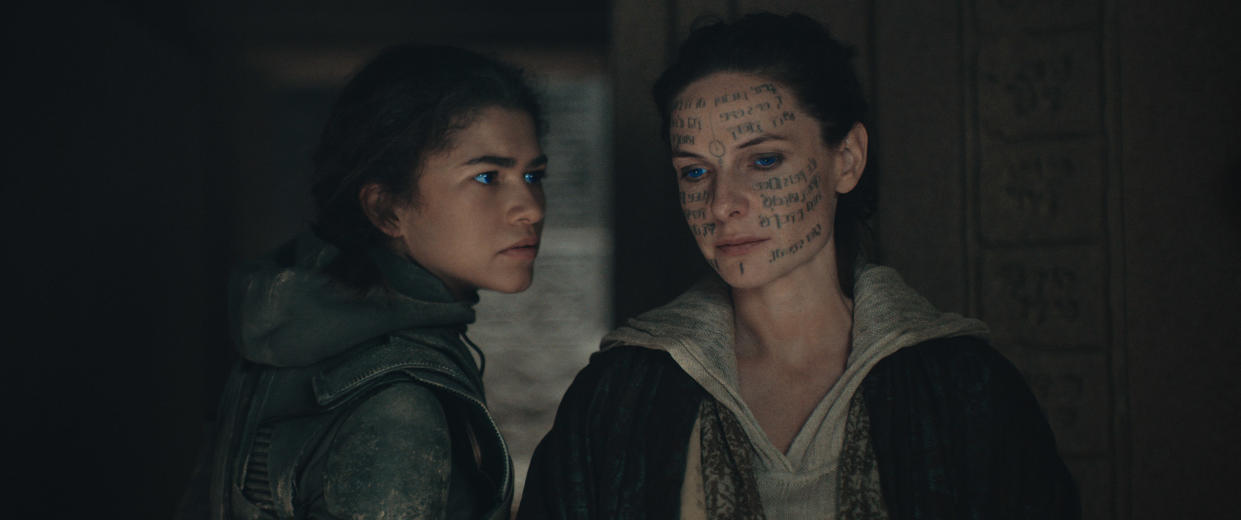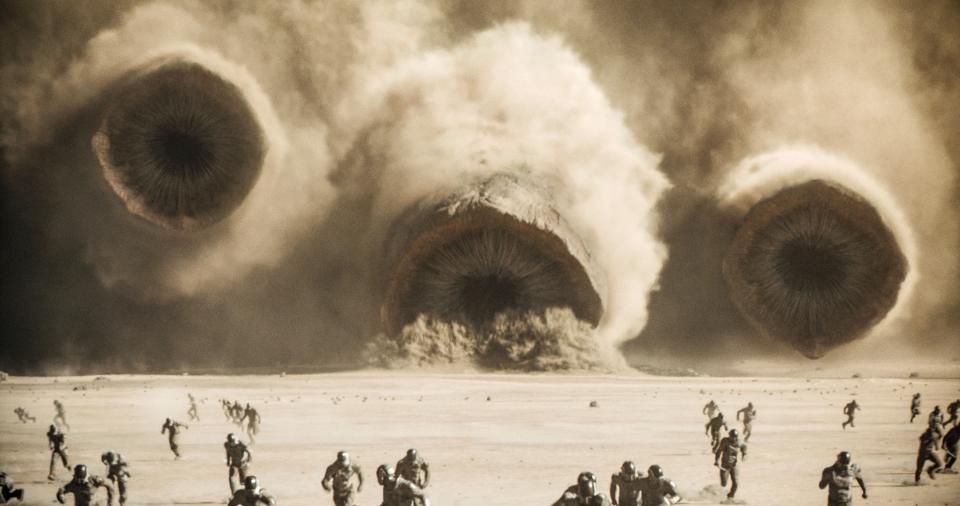Constructed Languages Don’t Always Make It Into a Finished Film — but ‘Dune: Part Two’ Shows Why They Should

- Oops!Something went wrong.Please try again later.
Nerds of a particular disposition once had to seek out a little red book by Ruth S. Noel called “The Languages of Tolkien’s Middle Earth,” from which you could learn two of the seven writing systems and look up definitions in 14 of the 15 languages that J.R.R. Tolkien spent his life inventing. But the internet has increased the accessibility of many things and therefore increased the hunger for many things: among them fan wikis with definitions for every thrown-away word in a made-up language in every fantasy story ever written. Frank Herbert’s “Dune” is no different.
But it is one thing to pepper in some extra js and dhs and q-apostrophes to make certain words look fantastical to native English speakers and another thing entirely to create a language system that makes sense. This challenge is precisely the task facing linguists David and Jessie Peterson for “Dune: Part 2,” which features a fair bit of dialogue in Chakobsa, the language of the Fremen.
More from IndieWire
The 65 Best Sci-Fi Movies of the 21st Century, from 'Melancholia' and 'M3GAN' to 'Asteroid City'
Adam Sandler Is #1 at Netflix, but How Many Knew 'Spaceman' Was a Drama About a Lonely Astronaut?
Like every natural language on Earth, a constructed language, or conlang, has at least some form of grammar. A conlang that strives to mimic our real-world languages can also build storytelling cues into its lexicon, the collection of vocabulary words that a particular conlang does (or doesn’t) have.
Doing this from scratch can be a lot of fun. Doing this with a set of words from an original source text and having all of those still make sense can be tricky. Frank Herbert didn’t invent a lot of Fremen vocabulary out of whole cloth, according to David Peterson, but transposed or altered words from other languages and gave them different meanings — many of them from Arabic, some of them directly from Middle Eastern and North African history, which underlines for a reader the colonial, Orientalist nature of the liberation struggle that Herbert transposed to the far future. But not always. Peterson traced the longest existing phrase in Chakobsa, a funeral rite spoken for Jamis (Babs Olusanmokun) as his water is given to the well at Sietch Tabr, to a Romani nursery rhyme.
“He just changed the meaning and said that it had something to do with water,” Peterson told IndieWire. “A lot of [Chakobsa] is just borrowed kind of haphazardly from different languages. We just had to come up with our own system and incorporate it as best we could.”
It is, ultimately, the writer’s choice to use words from any language in order to create their desired effect. Even if one isn’t read into the 10,000 years of “Dune” lore, Herbert’s use of real world titles — linguistically, Paul Atreides (Timothée Chalamet) is just as much a “son of Atreus” as Agamemnon is in “The Iliad” — and Herbert’s reliance on specific adventure story tropes based around the Madhist War and the Arab Revolt gives the Imperium in “Dune” a crushing, cyclical scope. But if you’re going to put linguists on the case? Then they’ll give you a language that has its own integrity, history, and contradictions. It was in trying to create logical linguistic connections between very unrelated words that some of the rules of a Fremen conlang came into focus for Peterson.
The Romani nursery rhyme for counting off that Herbert used for a funeral rite, for instance, starts with some very similar-sounding words. So Peterson figured the way that Chakobsa would make sense of it would be to create different noun cases out of shifts in stress on a word — English has almost no noun cases, but in a lot of other languages, they’re the difference between a phrase having meaning and “Romanes eunt domus.”
“Basically I started with the word for water, and then I grabbed other words that were from the books and had a very definite meaning. The word for sun, the word for heart. And then I created something so that we could get shadout to mean well-dipper somehow,” Peterson said. “The main [challenge] is how can we support the forms that exist? And the suggestion of grammar, if it’s there or if there isn’t any: What grammar can we create that isn’t contradicted by what’s already there?”

For some projects, this is easier than others. “There are projects where we’ve worked on where every single utterance is a command. And so really, as long as you know how to say, ‘run,’ ‘open the door,’ ‘stop,’ you just need a grammar in place to do these imperative forms,” Jessie Peterson told IndieWire. “You may never get into things like modifiers and relative clauses and all these more intricate things that require more detail.”
But “Dune 2” required a fair bit of detail, even if the grammatical structure was in place in the first film. A lot of the Petersons’ work was in thinking through how language evolution would assert itself in the vocabulary of Chakobsa and tailor word derivations to the story being told in Villeneuve’s film. The most everyday terms in any language — things like “hello” and “goodbye” — are often ones that have the most history behind them. “You don’t try to come up with a way to say hello. You try to come up with what would have been a common phrase that was repeated when you saw someone and which ended up getting reduced to a smaller form,” Jessie Peterson said.
The Petersons determined that the Fremen word for “goodbye,” for instance, would have derived from a phrase meaning to have courage or be brave, to “turn towards the wind,” and was shortened over the millennia that the Bene Gesserit laid their plots within plots. The Chakobsa language itself, therefore, is a record that speaks to the experience and outlook of a people living on a desert planet, prizing resiliency and courage as they wait for a prophesied savior from another world. Likewise, a specific way of seeing and cultural experience is why off-worlders call the device that attracts sandworms “thumpers” in English, but the Fremen word, habbin, takes a different journey to the same meaning. “It started with a word for to beat or to pulse, from which we also derived the word for drum, habib, and then basically habbin is a diminutive [that means] ‘little drum,’” David Peterson said.

The Fremen word for bone is similarly expressive, deriving from the word for rock or stone; it’s evidence embedded in language of how connected the Fremen saw themselves with the natural landscape of Dune as their language took shape. “When added to a verb, the Chakobsa suffix ‘-t’ generally acts like ‘er’ in English, where ‘teach’ becomes ‘teacher’ (or ‘a person who teaches’). In this case, it’s added to a noun and acts like a descriptor. A human being’s stone is a bone,” David Peterson said.
In their conlang documentation for Chakobsa, the Petersons use asterisks to flag words that are particularly interesting or fun, and on searching their work on “Dune 2,” they found 123 asterisks (which they thought might be too many to still count as shorthand). Every one of them represents a great deal of thought and creativity and fictional detective work to tell a story of characters through the language they use — even if only the actors saying the dialog truly know the difference, the difference is there.
The Petersons hope that the Chakobsa in “Dune 2” will continue a trend of American audiences being more receptive to subtitled dialogue (and/or studio execs understanding that American audiences can be receptive to subtitled dialogue). Because sometimes conlangs vanish from the finished project, and the linguists don’t know their work is gone until they sit down to watch.
“It’s one thing when that happens to us; it’s disappointing. But we’ve had stuff, you know? It’s really, really, really disappointing when that happens to others,” David Peterson said. “A conlanger named Bill Weldon created a language for the seraphim of the movie ‘Noah,’ and he did a great job and they were very happy with it. But for whatever reason, they decided, ‘It doesn’t make sense for them to talk.’ They just cut it entirely. There’s no scrap of his work in the film. He didn’t get credited. And that was that. Same thing happened with a friend of ours named Jake Penny. They created a language for ‘Madame Web,’ which just came out. All of their work was just cut, and they weren’t credited. They got paid for their work, so that’s an improvement. But… theoretically, it should have been something that could have gotten quite a bit of attention.”
Part of the Desert Power of “Dune,” though, is giving the Fremen their own language to speak. So if Denis Villeneuve does indeed make good on a Part 3 as he intends, it’s hard to imagine Chakobsa will vanish into the sands.
Best of IndieWire
The 65 Best Sci-Fi Movies of the 21st Century, from 'Melancholia' and 'M3GAN' to 'Asteroid City'
Christopher Nolan Movies, Ranked from 'The Dark Knight' and 'Tenet' to 'Dunkirk' and 'Oppenheimer'
Where to Watch This Week's New Movies, Including 'Argylle' and 'How to Have Sex'
Sign up for Indiewire's Newsletter. For the latest news, follow us on Facebook, Twitter, and Instagram.

